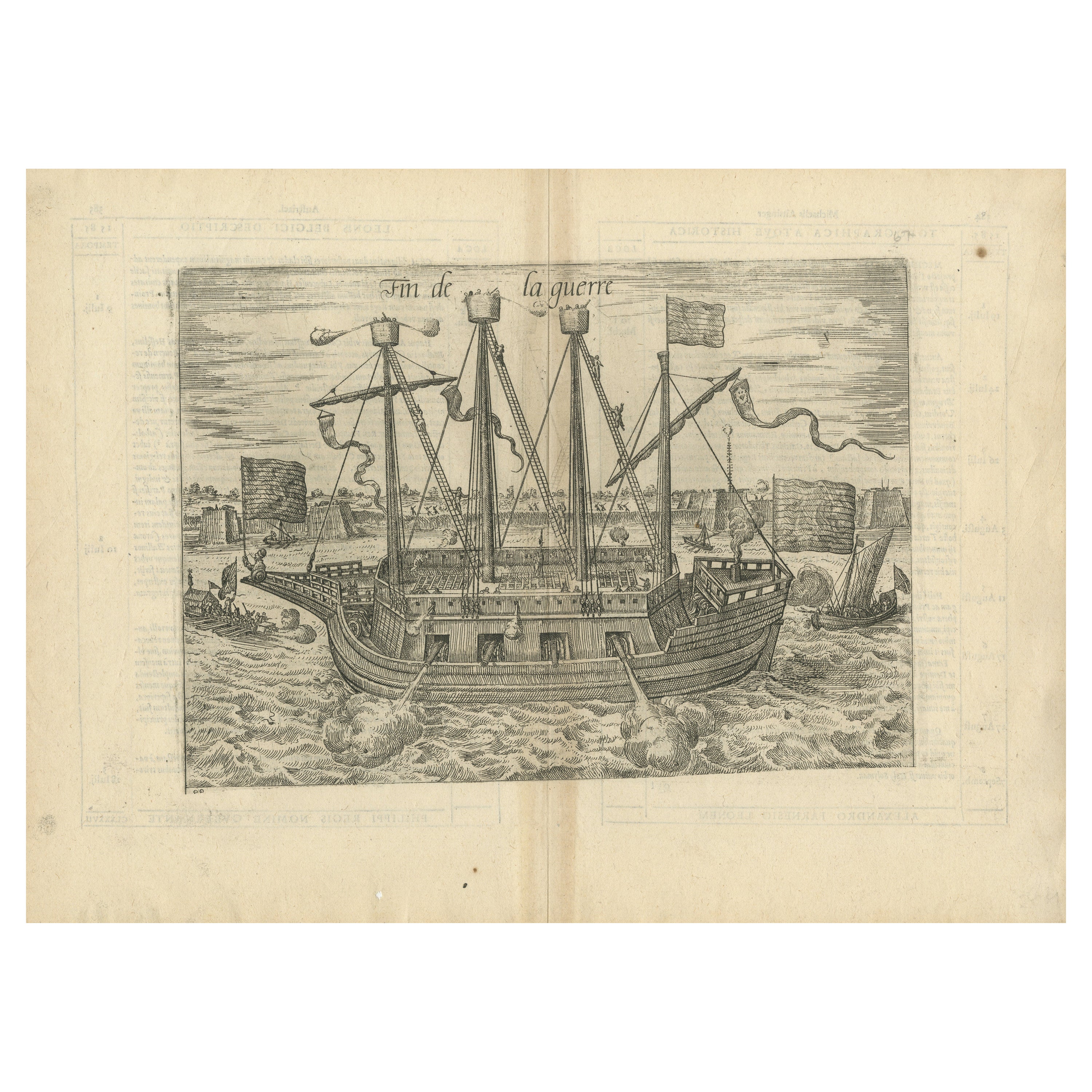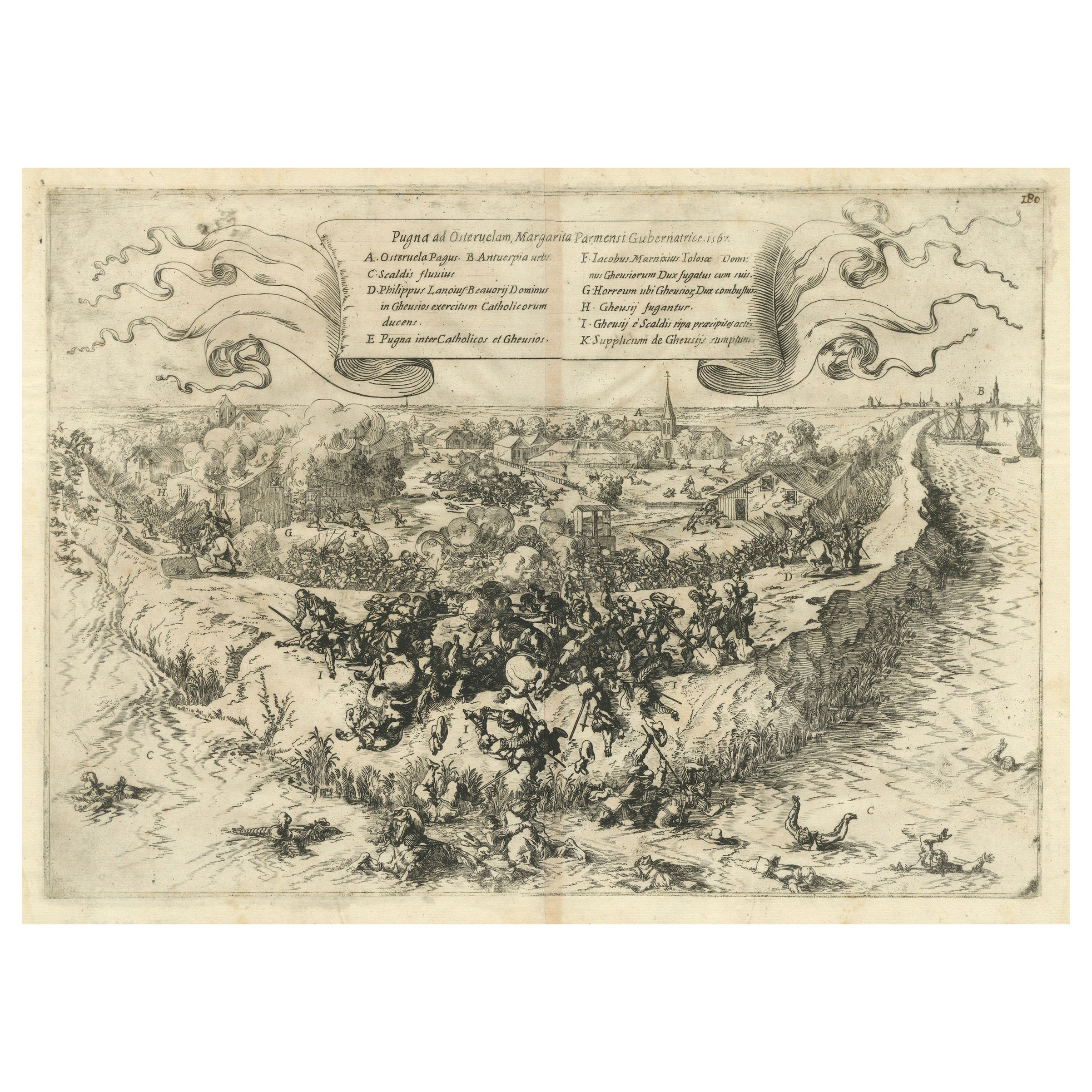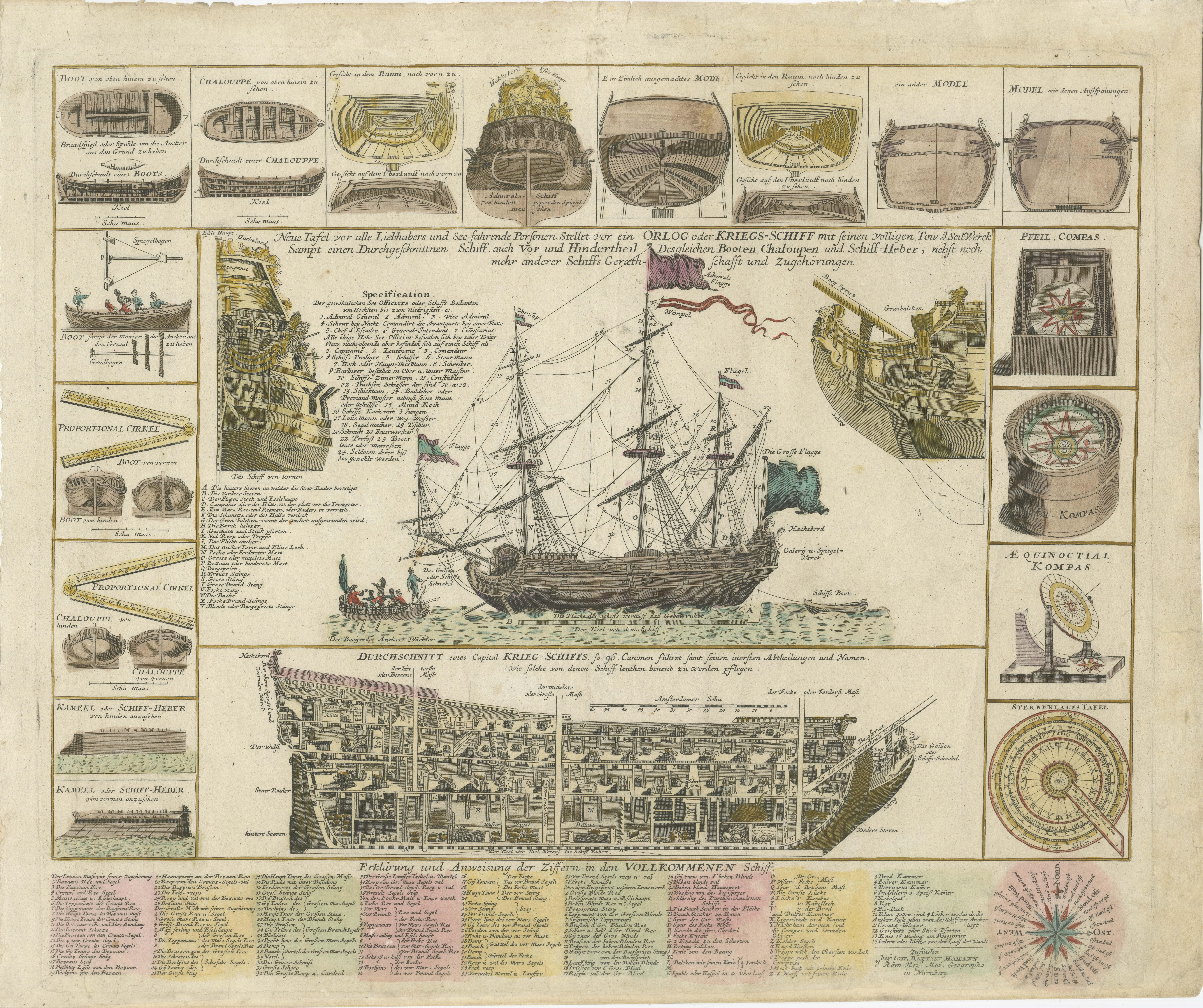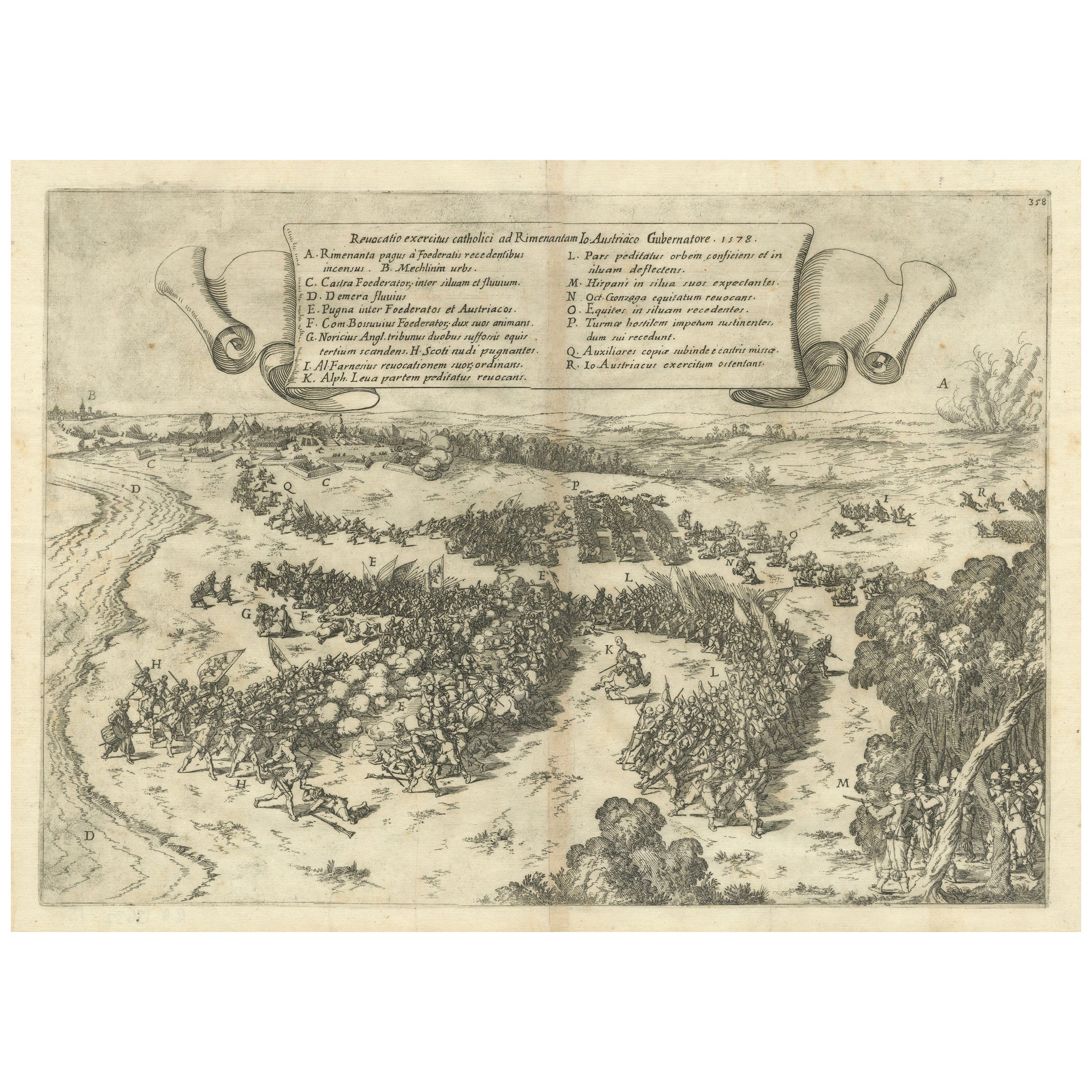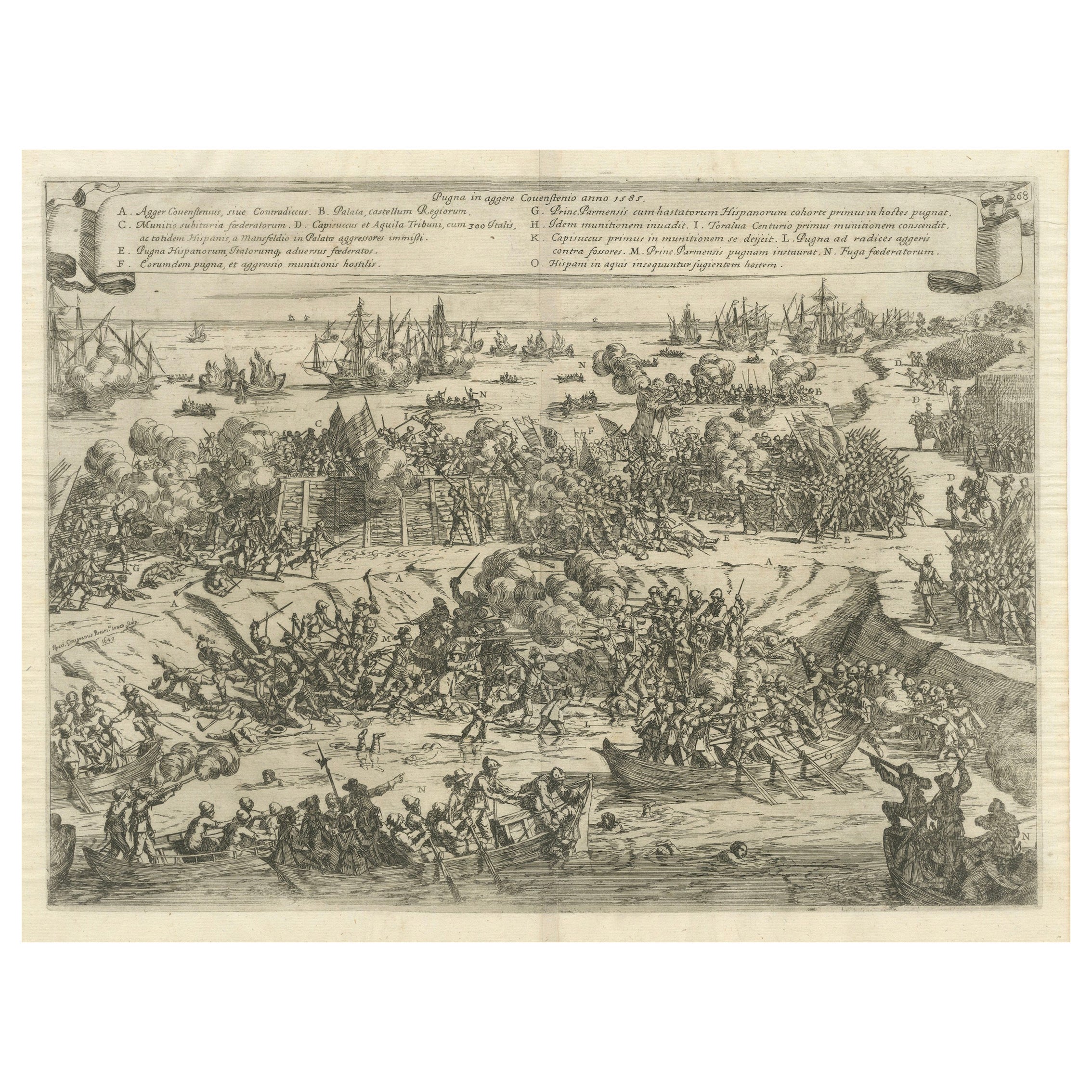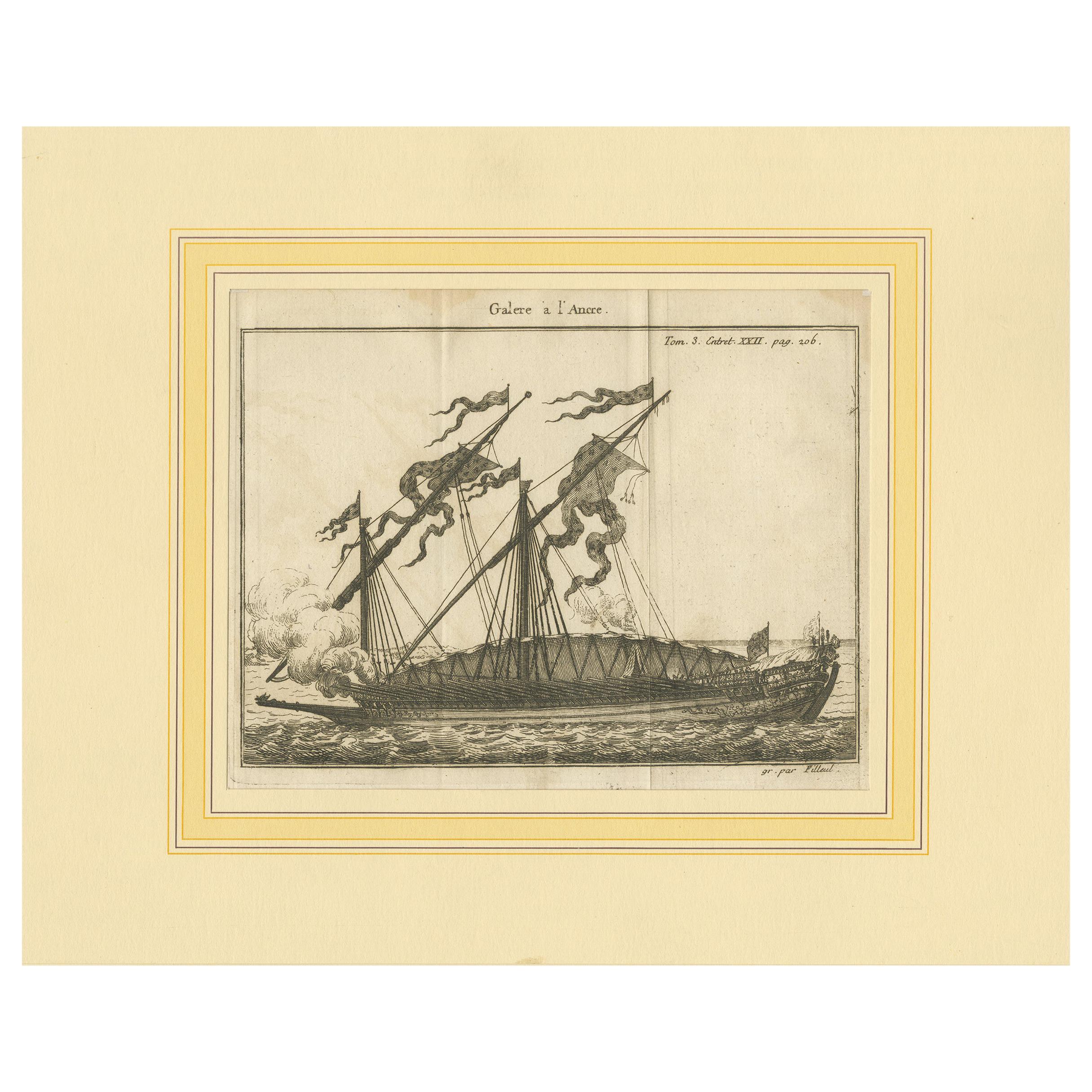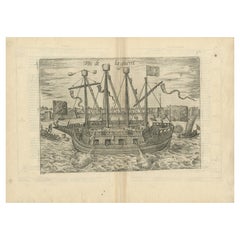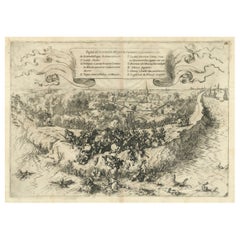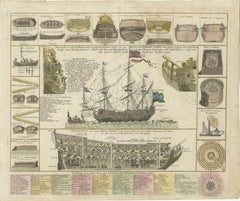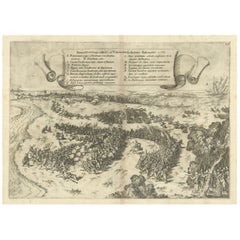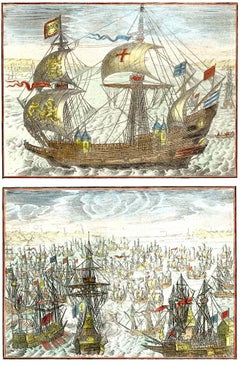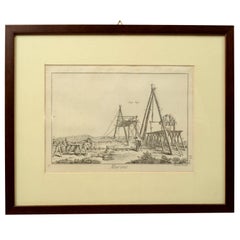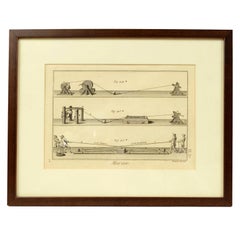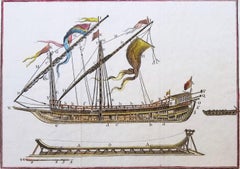Items Similar to Ingenious Destruction: Fire Ship Design of the Eighty Years' War, 1632
Want more images or videos?
Request additional images or videos from the seller
1 of 6
Ingenious Destruction: Fire Ship Design of the Eighty Years' War, 1632
$708.73
$885.9120% Off
£522.80
£653.4920% Off
€592
€74020% Off
CA$981.98
CA$1,227.4720% Off
A$1,065.60
A$1,331.9920% Off
CHF 564.67
CHF 705.8420% Off
MX$13,069
MX$16,336.2620% Off
NOK 6,987.77
NOK 8,734.7120% Off
SEK 6,603.07
SEK 8,253.8420% Off
DKK 4,507.97
DKK 5,634.9620% Off
About the Item
This original engraving is referring depicting a detailed illustration of a fire ship, a type of naval vessel used as a weapon during the Eighty Years' War.
Fire ships were essentially floating bombs, filled with combustibles and explosives, and set ablaze before being directed towards enemy ships or fortifications in an attempt to cause significant damage.
In this rare original print, the ship is shown in a cross-sectional view, allowing the viewer to understand the internal structure and components of the vessel. The image likely includes annotations corresponding to various parts of the ship, such as the location where the combustible materials were stored, details about the construction that facilitated the ship’s ability to carry and release the materials effectively, and possibly the mechanisms for steering the ship towards its target.
The Latin text in the image provided seems to describe technical aspects of a ship, detailing its construction or features. Here is the translation of the Latin text:
A. Foundation of the turret raised and strengthened by a base, one foot wide and three feet high, filled with war powder.
B. Walls above the foundation extended outward nearly touching the water, strengthened by two anchors.
C. Oppressed by stones thrown.
D. Roof made of similar materials as stones.
E. Ceiling of the turret made of iron, marble balls, and chains, and millstones arranged.
F. Square stones preferred to be used for the walls of the turret.
G. The deck of the ship hiding the turret and opening inwards.
H. Tunnel under the deck of the ship.
I. Sail to be spread under the middle of the ship tied, and carried by the current of the river inflated downward, and dragging the ship.
This text describes the structure of a fire ship (navis incendiaria cum cuniculo) and seems to be a detailed instruction on how to construct and utilize it, likely for military purposes. These ships could be used as weapons, set alight, and sent in the direction of the enemy to cause destruction, especially during naval battles. The precise measurements and the mention of "war powder" (bellico pulvere) suggest that this was a vessel intended to be filled with explosives. The specific terms used in the text, such as "cuniculo" (tunnel) and "velum" (sail), provide technical details on how the ship was engineered for its destructive purpose.
- Dimensions:Height: 13.9 in (35.3 cm)Width: 17.92 in (45.5 cm)Depth: 0 in (0.02 mm)
- Materials and Techniques:Paper,Engraved
- Period:1630-1639
- Date of Manufacture:1632
- Condition:Good, given age. General age-related toning, creasing and/or occasional minor defects from handling. Middle fold line as issued, slightly brownish. Please study scan carefully.
- Seller Location:Langweer, NL
- Reference Number:Seller: BG-13637-131stDibs: LU3054338527892
About the Seller
5.0
Recognized Seller
These prestigious sellers are industry leaders and represent the highest echelon for item quality and design.
Platinum Seller
Premium sellers with a 4.7+ rating and 24-hour response times
Established in 2009
1stDibs seller since 2017
2,622 sales on 1stDibs
Typical response time: <1 hour
- ShippingRetrieving quote...Shipping from: Langweer, Netherlands
- Return Policy
Authenticity Guarantee
In the unlikely event there’s an issue with an item’s authenticity, contact us within 1 year for a full refund. DetailsMoney-Back Guarantee
If your item is not as described, is damaged in transit, or does not arrive, contact us within 7 days for a full refund. Details24-Hour Cancellation
You have a 24-hour grace period in which to reconsider your purchase, with no questions asked.Vetted Professional Sellers
Our world-class sellers must adhere to strict standards for service and quality, maintaining the integrity of our listings.Price-Match Guarantee
If you find that a seller listed the same item for a lower price elsewhere, we��’ll match it.Trusted Global Delivery
Our best-in-class carrier network provides specialized shipping options worldwide, including custom delivery.More From This Seller
View AllFin de la Guerre: The Behemoth of the Siege of Antwerp, 1585
Located in Langweer, NL
This print depicts the Antwerp warship Fin de la guerre, a massive vessel constructed during the Siege of Antwerp (1584-1585).
It is a copperplate-engraved oblique profile of the D...
Category
Antique 16th Century Prints
Materials
Paper
$612 Sale Price
20% Off
First Sparks of the Eighty Years' War in Oosterweel in 1567, Engraved in 1632
Located in Langweer, NL
An original antique engraving of the Battle of Oosterweel, which took place in 1567 during the Dutch Revolt. It is an early conflict leading up to the full-scale Eighty Years' War. T...
Category
Antique 1630s Prints
Materials
Paper
$804 Sale Price
20% Off
Free Shipping
Detailed 1730 Maritime Warship Print with Tools, Rigging, and Ship Cross-Section
Located in Langweer, NL
Title: Detailed 1730 Maritime Warship Print with Tools, Rigging, and Ship Cross-Section
Description: This exceptionally detailed and decorative maritime print, published in Nurember...
Category
Antique 1730s German Prints
Materials
Paper
$2,298 Sale Price
20% Off
Clash at Rijmenam Engraved: A Turning Point in the Eighty Years' War, 1632
Located in Langweer, NL
Rare engraving depicting a battle in the Eighty Year' War.
The Battle of Rijmenam took place on July 31, 1578, during the early stages of the Eighty Years' War. It was a conflict between the States-General of the Netherlands and the Spanish governor-general, resulting in a Spanish defeat.
The forces of the States-General set up camp at Rijmenam under the overall leadership of the Count of Boussu. Their army consisted of 12,000 infantry and 7,000 cavalry. The English mercenaries were led by Sir John Norris and Sir Richard Bingham, the Scottish mercenaries by Robert Stuart, and the French Huguenots by François de la Noue.
Don Juan of Austria, the Spanish commander, commanded an army of 12,000 infantry and 5,000 cavalry. He planned to attack before reinforcements from Zutphen could arrive. His subordinates, Alexander Farnese and Gabrio Serbelloni, considered this too risky, but Don Juan proceeded with his plan and launched an early morning attack on July 31. He attempted to draw Boussu out for an open field battle, but Boussu stayed behind the dug trenches.
After three hours of waiting, Don Juan ordered a company of musketeers under Alonso de Leyva and three groups of cuirassiers under the Marquis del Monte to stage a feigned attack on the village's rear. In response, Boussu sent Norris to confront them. Following the initial skirmish, Scottish forces under Stuart and Spanish infantry under Fernando Álvarez de Toledo...
Category
Antique 1630s Prints
Materials
Paper
$754 Sale Price
25% Off
Free Shipping
Siege and Struggle: The Kauwensteinse Dike in the Eighty Years' War, 1647
Located in Langweer, NL
Battle on the Kauwensteinse dike, 26 mai 1585, attack from the Staten army and ships from Sealand on the dike against the Spanish in the Eighty Years' War.
An original historical ar...
Category
Antique 1640s Prints
Materials
Paper
$804 Sale Price
20% Off
Free Shipping
Antique Print of an Anchored Ship by Pluche '1735'
Located in Langweer, NL
Antique print titled 'Galere a l'Ancre'. Original antique print of an anchored ship. This print originates from 'Le spectacle de la nature, ou Entretiens sur les particularités (..)'...
Category
Antique Mid-18th Century Prints
Materials
Paper
$143 Sale Price
20% Off
You May Also Like
Two naval images depicting 17th century warships
Located in Middletown, NY
French School 20th century
Two naval images depicting 17th century warships flying various flags, including the Plantagenet Lions and St. George's Cross. (2)
c1950. Two engravings w...
Category
20th Century French School Still-life Prints
Materials
Watercolor, Engraving
Engraving Print from the Panckoucke Encyclopédie Nautical Subject 1782-1832
Located in Milan, IT
Print by engraving on copper plate from the Panckoucke Encyclopédie méthodique, end of the 18th century,volume Marine Planches (more than 1,500 figures dealing with all subjects on the marina: planes, construction, carpentry, tree trunks, armaments of maneuvers, ropes, sails, artillery, ship maneuvers and combat tactics). This is the plate no. n. 24, pag. 69 fig. 341 ; with frame cm 38.3 x 31.5. Ship ropes are depicted. The Print has the "Benard direxit...
Category
Antique 1790s French Nautical Objects
Materials
Paper
Engraving Print from the Panckoucke Encyclopédie Nautical Subject, 1782-1832
Located in Milan, IT
Print by engraving on copper plate from the Panckoucke Encyclopédie méthodique, end of the 18th century, volume Marine Planches (more than 1,500 figures dealing with all subjects on the marina: planes, construction, carpentry, tree trunks, armaments of maneuvers, ropes, sails, artillery, ship maneuvers and combat tactics). This is the plate no. n. 26, pag. 70 fig. 350-353; with frame cm 38.3 x 31.5. Ship ropes are depicted. The Print has the "Benard direxit...
Category
Antique 1790s French Nautical Objects
Materials
Paper
Draught of a Galley /// Old Masters Ship Boat Seascape Construction Diagram Art
By William Henry Toms
Located in Saint Augustine, FL
Artist: William Henry Toms (English, c.1700-1765)
Title: "Draught of a Galley" (Plate 13, Vol. III, page 131)
Portfolio: La Spectacle de la Nature
Year: 1737
Medium: Original Hand-Colored Engraving on laid paper
Limited edition: Unknown
Printer: Unknown, London, UK
Publisher: Humphreys, London, UK
Framing: Recently framed in a Regency style gold moulding with 100% cotton rag matting and 99% UV protective Museum Glass. The frame is an antique frame we've reused, originally built by Knoedler Gallery, New York, NY
Framed size: 10.25" x 10.25"
Sheet size (irregular margins): 6.63" x 8.25"
Image size: 4.75" x 6.75"
Condition: In excellent condition with strong colors and good margins
Rare
Notes:
Comes from the 1737 volume edition of Noël-Antoine Pluche's "La Spectacle de la Nature", translated from the original French by Humphreys as "Nature Displayed". With two soft vertical folds within paper as issued. Various dealer reference numbers and an old price pencil inscribed in margins and on verso.
Biography:
William Henry Toms (c. 1700–1765) was an English engraver. He worked on portraits, book-plates, landscapes and prints of buildings. Among his works were the plates for Robert West's "Perspective Views of All the Ancient Churches in London" (1736–1739). In 1741, he worked with Thomas Badeslade on "Chorographia Britanniae or a New Set of Maps of all the Counties in England and Wales". The maps were republished on 29 September 1742, with additional place names. Among Toms's apprentices was the engraver and publisher John Boydell. W. H. Toms lived in Masham Street, London, and was the father of the painter Peter Toms. Toms died in 1765.
Noël-Antoine Pluche (1688-1761) , known as the abbé Pluche, was a French priest...
Category
1730s Baroque More Prints
Materials
Watercolor, Laid Paper, Engraving, Intaglio
Frederick Chapman: ‘Naval Architecture War Vessels’, circa 1770
Located in Lymington, Hampshire
FREDERICK CHAPMAN: ‘Naval Architecture War Vessels’, circa 1770, , 50 engraved plates of various sizes depicting naval diagrams (numbered I-XXVI), four signed ‘F. Ringheim’and one ea...
Category
Antique 18th Century Swedish Books
Materials
Paper
Daniel Marot's The Siege of the Dutch Fortified City of Ypres by Louis XIV
By Daniel Marot
Located in Alamo, CA
"Ypres, Grand Ville Riche & Marchande" is an engraving and etching by Daniel Marot (le Vieux) (1661–1752). It depicts a view of the siege of the city of Ypres and its citadel on the left in the Spanish Netherlands by Louis XIV's troops. This battle took place between March 18 and March 25, 1678, as part of the Franco-Dutch War. Marot illustrated in great detail (best appreciated with magnification) the French attack on the strong pentagonal citadel on the extreme left, which had been built recently in anticipation of a French attack. The trenches built by the French approaching the town are seen on the right. King Louis XIV can be seen in the foreground surveying the battle mounted on his white horse, surrounded by his officers and troops.
The print is presented in an attractive ornate black wood frame with a cream-colored double mat with a black inner trim. It is glazed with plexiglas. The frame measures 25.38" x 22.63" x .88". The engraving, frame, mat and glazing are in excellent condition.
Artist: Daniel Marot (1661–1752) was also called "Le Vieux". He was the son of the famous architect, Jean Marot. Marot had diverse interests and talents. In addition to his art, he designed garden projects, architectural ornaments, furniture, and even upholstery. Marot as a Huguenot protestant was forced to leave France in 1685 following the revocation of the Edict of Nantes. He emigrated to Holland, where he worked for William of Orange (an arch enemy of his former employer Louis XIV). Marot was largely responsible for the interiors of Williams palace at the Loo. In 1694 he went Britain as William had married Queen Mary and he had become King William III of England. He later returned to Holland in about 1698 and died in the Hague in 1752. He left a lasting legacy on the decorative arts in the Netherlands, where his grand version of the Louis XIV style remained popular into the 1730s.
Historical Background: In October 1677, Mary Stuart, niece and possible successor of Charles II of England, married Louis XIV's arch enemy William III of Orange...
Category
Late 17th Century Old Masters Landscape Prints
Materials
Engraving, Etching
More Ways To Browse
Eighties Furniture
Astronomical Clock
Austrian Pug
Aztec Stone
B Altman Vintage
Beetles Sculpture
Bencharong Porcelain
Biedermeier Marble Top
Bird Sculpture Plated
Birds Eye Maple Chest
Black Japanese Chest
Black Lacquer Asian Painting
Black Lacquer Chinoiserie Chest
Black Squirrel
Blue Biedermeier
Blue Elephant Ceramic
Bonbon Dish
Bow Front Chest 4 Drawers
